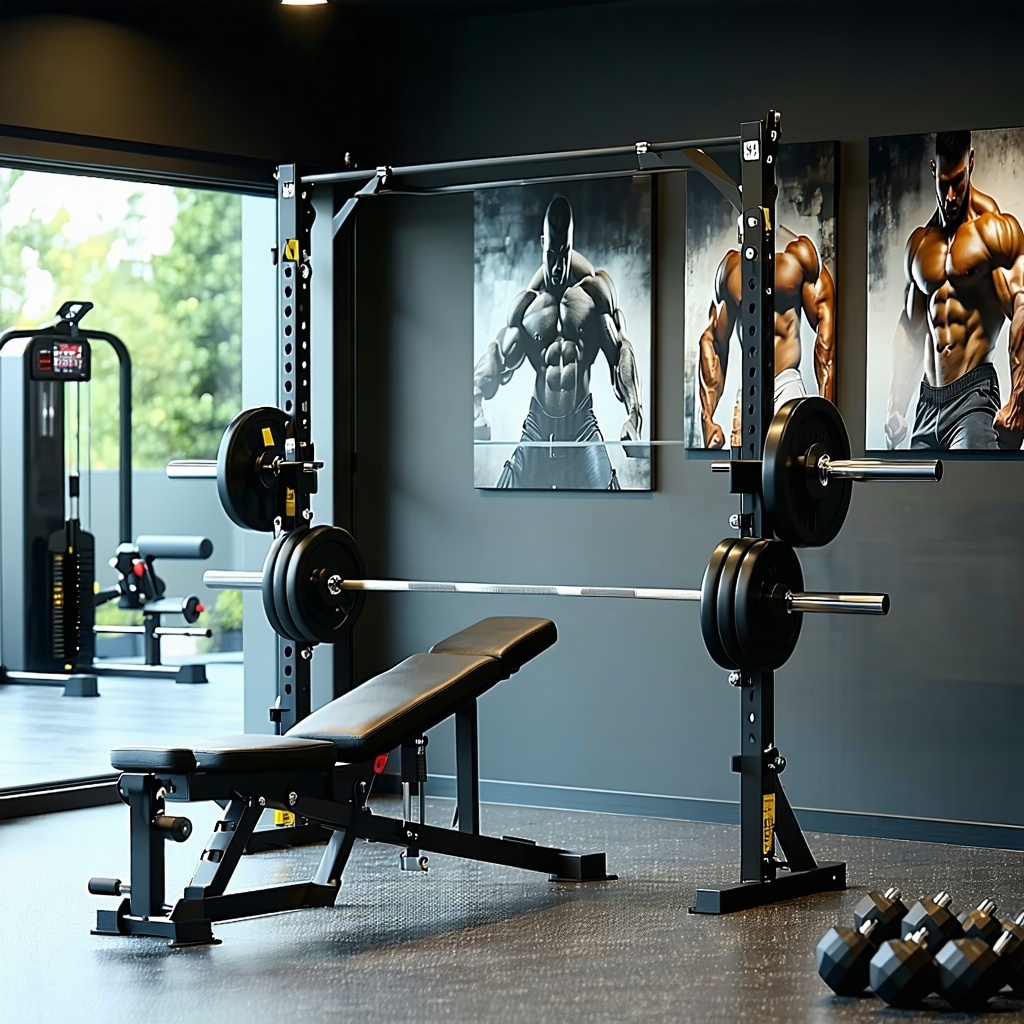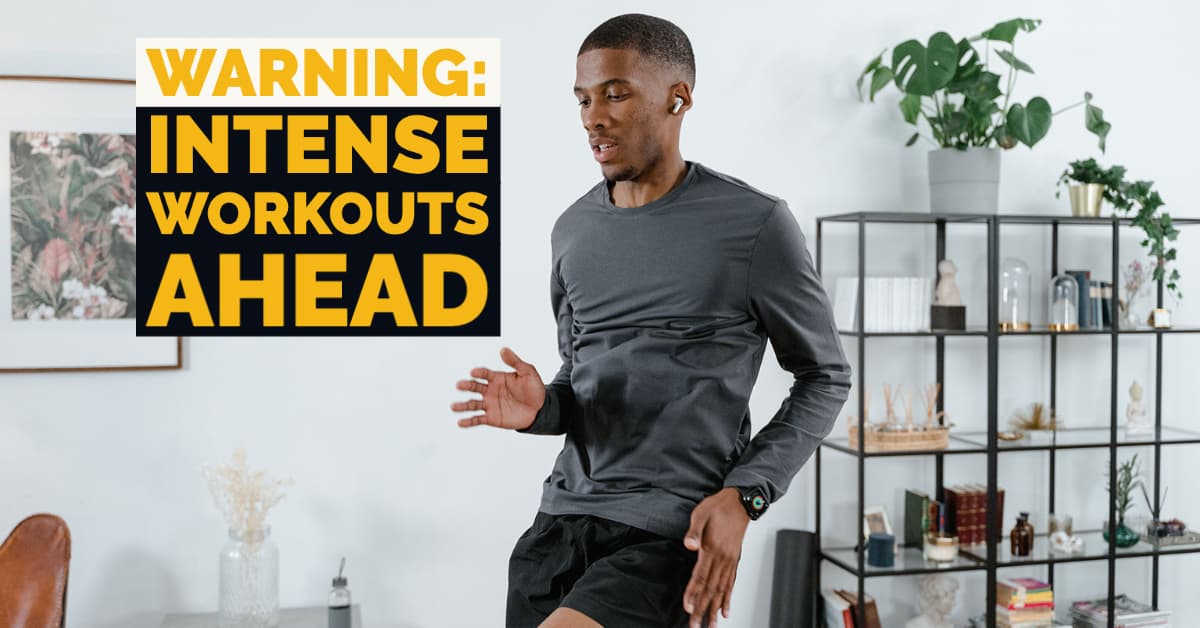The 5-Day Push-Pull-Legs Split: High-Frequency Muscle Building for Serious Lifters
You've mastered the fundamentals, built impressive strength and size with lower frequency routines, and now you're ready for the next level: high-frequency training that maximizes muscle protein synthesis and accelerates your progress like never before. The 5-day push-pull-legs split isn't just another step up in volume – it's a complete paradigm shift that transforms dedicated intermediate lifters into impressive advanced athletes.
This routine represents the sweet spot of muscle building frequency, training each muscle group every 2-3 days to maintain constantly elevated protein synthesis while allowing adequate recovery between sessions. You'll experience muscle growth rates that seemed impossible with lower frequency training, while developing the work capacity and recovery ability that separate serious lifters from weekend warriors.
What makes this 5-day PPL split revolutionary isn't just the increased frequency – it's the intelligent distribution of volume and intensity that maximizes stimulus while managing fatigue. You'll have heavy days, moderate days, and lighter days, each serving a specific purpose in your overall development. This sophisticated approach prevents the burnout that destroys many high-frequency attempts while delivering results that will amaze you and everyone around you.
This program will transform not just your physique, but your entire approach to training and recovery. You'll learn to listen to your body's signals, adjust training variables based on daily readiness, and optimize every aspect of your lifestyle to support maximum muscle growth. These skills will serve you throughout your lifting career, whether you eventually pursue competitive bodybuilding, powerlifting, or simply want to maintain an impressive physique for life.
The Science of High-Frequency Training
High-frequency training isn't just about doing more work – it's about optimizing the biological processes that drive muscle growth. Understanding the science behind this approach helps you appreciate why it's so effective and how to implement it for maximum results.
Muscle protein synthesis (MPS) is the process by which your body builds new muscle tissue, and it's the key to understanding optimal training frequency. Research shows that MPS peaks 24-48 hours after training and returns to baseline within 48-72 hours. By training each muscle group every 48-72 hours, you're maximizing the time your muscles spend in this elevated growth state.
The frequency-volume relationship is crucial for intermediate and advanced lifters. While beginners can make progress with almost any frequency, more experienced lifters need higher frequencies to continue stimulating adaptation. The 5-day PPL split allows you to distribute 16-20 sets per muscle group across multiple sessions, providing superior stimulus compared to cramming all that volume into one or two weekly sessions.
Neurological recovery patterns support high-frequency training when properly implemented. Different movement patterns use different neural pathways, so while your pushing muscles and nervous system are recovering from Monday's workout, you can train pulling movements on Tuesday without interference. This allows for higher overall training frequency without overloading any single system.
Hormonal optimization occurs with properly structured high-frequency training. Regular training sessions maintain elevated testosterone and growth hormone levels while preventing the excessive cortisol elevation that can occur with overly long, infrequent sessions. The result is an optimal hormonal environment for muscle growth and recovery.
Metabolic adaptations improve with consistent high-frequency training. Your muscles become more efficient at utilizing nutrients, clearing metabolic waste, and recovering between sessions. This improved efficiency allows you to handle higher training loads while recovering more quickly than with lower frequency approaches.
Program Architecture and Periodization
This 5-day PPL split incorporates sophisticated programming concepts that optimize muscle growth while preventing overtraining and plateaus. The structure represents years of refinement and real-world testing with serious lifters who demand maximum results.
The program follows a Push-Pull-Legs-Push-Pull rotation over 5 days, with 2 rest days per week. This structure ensures that each muscle group is trained every 2-3 days while allowing adequate recovery between sessions targeting the same movement patterns. The rotation can be adjusted based on your schedule and recovery needs.
Volume is distributed intelligently across the week, with 16-20 sets per muscle group spread across 2-3 sessions. This distribution allows for higher total volume than lower frequency approaches while maintaining quality and intensity throughout each session. The key is managing fatigue accumulation while maximizing stimulus.
Intensity varies throughout the week using an undulating periodization model. You'll have heavy days (5-8 reps), moderate days (8-12 reps), and lighter days (12-20 reps), each serving a specific purpose in your overall development. This variation prevents adaptation to any single training stimulus while optimizing different muscle building pathways.
Exercise selection combines compound movements for maximum muscle activation with isolation exercises for complete development and weak point correction. Each session includes 1-2 heavy compound movements followed by 3-4 moderate to light accessory exercises, ensuring both strength development and aesthetic improvements.
Recovery is built into the program structure through strategic exercise selection, volume distribution, and intensity management. While the frequency is high, the daily volume is manageable, allowing for quality training without excessive fatigue accumulation.
Push Day A: Heavy Emphasis
The first push session of the week emphasizes maximum strength development through heavy compound movements. This session sets the tone for your training week and allows you to handle your heaviest loads while you're completely fresh and motivated.
Barbell Bench Press: 4 sets of 5-8 reps
The bench press opens your training week with maximum intensity and focus. Starting with your heaviest, most demanding exercise while you're completely fresh allows for optimal performance and progression. This lower rep range emphasizes strength development while providing excellent muscle building stimulus.
Your setup becomes critical when handling near-maximal weights twice per week. Take extra time to position yourself properly, create maximum tension throughout your body, and establish perfect bar path before attempting heavy sets. Consider using a spotter for your heaviest sets to ensure safety and confidence.
Progress by adding 2.5-5 pounds every 1-2 weeks, focusing on the lower end of the rep range with maximum weights. The higher frequency allows for more conservative progression that compounds over time to produce impressive strength gains.
Overhead Press: 3 sets of 6-10 reps
The overhead press provides additional pressing volume while targeting your shoulders and triceps with a different movement pattern. Following the bench press with overhead pressing creates optimal muscle activation while managing fatigue effectively.
Use strict form with no leg drive or excessive back arch. The weight should travel in a straight vertical line, with your head moving slightly back to allow clearance. The higher training frequency means you can use slightly lighter weights while still making excellent progress.
Focus on perfect form and controlled movement rather than maximum weight. The frequent training sessions will drive progress through consistent stimulus rather than single maximal efforts.
Incline Dumbbell Press: 3 sets of 8-12 reps
The incline dumbbell press targets your upper chest and front delts while providing a different training stimulus than the barbell movements. Using dumbbells allows for greater range of motion and helps address any strength imbalances.
Set the bench to a 30-45 degree incline and focus on feeling the upper chest work throughout the full range of motion. The moderate rep range provides excellent muscle building stimulus after the heavier compound movements.
This exercise works well in the middle of your session, providing quality volume without the technical demands of the heavier exercises. Focus on smooth, controlled movement and excellent mind-muscle connection.
Lateral Raises: 3 sets of 12-20 reps
Lateral raises provide direct stimulation for your side delts, building the shoulder width that creates an impressive V-taper. This isolation exercise ensures complete shoulder development while being easy to recover from.
Hold dumbbells at your sides with a slight bend in your elbows. Raise the weights out to your sides until your arms are parallel to the floor, then lower with control. Focus on leading with your elbows rather than your hands.
Use moderate weights and higher repetitions for this exercise. The goal is muscle activation and metabolic stress rather than maximum weight moved. Perfect form is more important than heavy weight.
Close-Grip Bench Press: 3 sets of 10-15 reps
The close-grip bench press provides additional tricep stimulation while reinforcing the pressing pattern. This exercise helps build the tricep strength that will improve your performance on all pressing movements.
Use a grip that's about shoulder-width apart and keep your elbows closer to your body than in a regular bench press. Focus on pressing with your triceps rather than your chest, using a weight that's 70-80% of your regular bench press.
This exercise provides excellent tricep development while being easy to recover from. The higher rep range creates metabolic stress that complements the mechanical tension from the heavier exercises.
Pull Day A: Heavy Emphasis
The first pull session emphasizes maximum strength development in pulling movements while building the thick, wide back that's the foundation of an impressive physique. This session balances the heavy pressing work while developing pulling strength and muscle mass.
Weighted Pull-ups or Heavy Lat Pulldowns: 4 sets of 5-10 reps
Pull-ups are the ultimate upper body pulling exercise, and when performed with additional weight, they become one of the most effective mass builders for your entire upper body. If you can't perform weighted pull-ups, heavy lat pulldowns provide an excellent alternative.
For weighted pull-ups, add weight gradually using a dip belt or holding a dumbbell between your legs. Focus on controlled movement and full range of motion rather than maximum weight. Pull yourself up until your chin clears the bar, then lower with control.
For lat pulldowns, use an overhand grip slightly wider than shoulder-width and pull the bar to your upper chest. Focus on squeezing your shoulder blades together and pulling your elbows down and back rather than just moving your hands.
Barbell Rows: 4 sets of 6-10 reps
Barbell rows provide horizontal pulling to complement the vertical pulling of pull-ups/pulldowns. This exercise targets your middle traps, rhomboids, and rear delts while building the thickness that creates an impressive back.
Maintain a consistent hip hinge position throughout all sets and pull the bar to your lower chest or upper abdomen. Focus on pulling with your back muscles rather than your arms, initiating each rep by squeezing your shoulder blades together.
The higher training frequency allows for more conservative weight increases while still making excellent progress. Focus on perfect form and feeling your back muscles work throughout the full range of motion.
Seated Cable Rows: 3 sets of 8-12 reps
Seated cable rows provide additional horizontal pulling with constant tension throughout the range of motion. This exercise allows you to focus purely on the pulling motion without the stability demands of bent-over rows.
Sit with your chest up and shoulders back, pulling the handle to your lower chest while squeezing your shoulder blades together. The seated position allows for excellent form and mind-muscle connection.
Use this exercise to really focus on feeling your back muscles work. The constant tension from the cable provides excellent stimulus while being easy to recover from between sessions.
Face Pulls: 3 sets of 15-20 reps
Face pulls target your rear delts, middle traps, and rhomboids – muscles that are crucial for shoulder health and balanced development. This exercise helps counteract the forward shoulder posture that can develop from excessive pressing.
Set a cable machine to chest height and pull the rope toward your face, separating the ends as you pull. Focus on squeezing your shoulder blades together and pulling your elbows back rather than just moving your hands.
Use lighter weights and higher repetitions for this exercise. The goal is muscle activation, postural improvement, and injury prevention rather than maximum weight moved.
Barbell Curls: 3 sets of 10-15 reps
Barbell curls provide direct bicep training to complement all the pulling work. While your biceps are already worked during rowing and pulling exercises, dedicated arm work ensures complete development and impressive arm size.
Stand with feet hip-width apart and curl the weight up using only your biceps – no swinging or momentum. Focus on the eccentric (lowering) portion of each rep, taking 2-3 seconds to return to the starting position.
The higher training frequency means you don't need to completely exhaust your biceps in one session. Focus on quality repetitions and consistent progression over time.
Legs Day A: Squat Dominant
The first leg session emphasizes squatting movements and quad development while providing comprehensive lower body training. This session builds the foundation of lower body strength and mass that supports all athletic endeavors.
Back Squat: 4 sets of 5-8 reps
The squat remains the king of all exercises, and in this high-frequency program, you'll squat twice per week with different emphases. This first session focuses on maximum strength development through heavy weights and lower repetitions.
Your squat technique should be refined by now, but the higher frequency means you can focus on perfect form rather than maximum weight. Take time to set up properly and maintain perfect form even as the weights become challenging.
Progress conservatively but consistently, adding 5-10 pounds every 1-2 weeks. The higher frequency allows for more gradual progression that compounds over time to produce impressive strength gains.
Romanian Deadlift: 3 sets of 8-12 reps
Romanian deadlifts provide perfect balance to the squat, targeting your hamstrings and glutes while teaching the hip hinge pattern. This exercise develops the posterior chain strength that supports heavy squatting.
Focus on the stretch in your hamstrings as you lower the weight and drive your hips forward to return to the starting position. Keep the bar close to your body throughout the movement.
The moderate rep range and controlled tempo make this exercise perfect for building muscle while being easy to recover from between sessions.
Bulgarian Split Squats: 3 sets of 10-15 reps per leg
Bulgarian split squats provide unilateral training while challenging your balance and single-leg strength. This exercise helps address strength imbalances while providing excellent muscle building stimulus.
Place your rear foot on a bench with most of your weight on your front leg. Lower yourself until your front thigh is parallel to the floor, then drive through your front heel to return to the starting position.
This exercise often reveals strength differences between your legs. Focus on using the same weight and rep range for both legs to promote balanced development.
Leg Curls: 3 sets of 12-15 reps
Leg curls provide direct hamstring training to complement the hip hinge movements and ensure complete posterior chain development. This isolation exercise helps balance the quad-dominant squatting movements.
Focus on curling your heels toward your glutes using only your hamstrings. Squeeze at the top of each rep, then lower with control. Don't use momentum or swing the weight.
The isolation nature of this exercise makes it easy to recover from while providing targeted stimulus for hamstring development.
Calf Raises: 4 sets of 15-20 reps
Calf training is essential for balanced lower body development. The higher training frequency allows you to train calves more often while using moderate volume per session.
Rise up on your toes as high as possible, squeeze at the top, then lower with control until you feel a stretch in your calves. Focus on full range of motion and controlled tempo.
Push Day B: Volume Emphasis
The second push session of the week emphasizes higher volume and moderate weights, focusing on muscle building through increased training stress and metabolic demand. This session complements the strength focus of your first push workout.
Incline Barbell Press: 4 sets of 8-12 reps
The incline barbell press targets your upper chest and front delts while providing a different training stimulus than the flat bench press. Starting with this exercise in your second push session provides variety while targeting an often-lagging muscle group.
Set the bench to a 30-45 degree incline and focus on pressing the bar up and slightly back toward your head. The moderate rep range provides excellent muscle building stimulus while being manageable after your heavy bench press session earlier in the week.
Focus on feeling the upper chest work throughout the full range of motion rather than maximum weight moved. The higher frequency means you can make progress with moderate weights and perfect form.
Dumbbell Shoulder Press: 3 sets of 10-15 reps
Dumbbell shoulder pressing provides additional shoulder development while allowing for a more natural pressing motion than barbell movements. This exercise helps build three-dimensional shoulder development while addressing strength imbalances.
Start with dumbbells at shoulder level and press straight up until your arms are fully extended. The independent movement of each arm requires greater stabilization and coordination than barbell pressing.
Focus on smooth, controlled movement and feeling your shoulders work throughout the full range of motion. The moderate weights and higher repetitions provide excellent muscle building stimulus.
Dips: 3 sets of 10-15 reps
Dips provide an excellent bodyweight exercise for your chest, shoulders, and triceps while teaching you to handle your own body weight effectively. This exercise provides a different angle of stimulation than pressing movements.
If bodyweight dips are too easy, add weight with a dip belt. If they're too difficult, use an assisted dip machine or resistance bands. The goal is to work in the target rep range with challenging but manageable resistance.
Lean slightly forward to emphasize chest involvement, or stay more upright to focus on triceps development. Lower yourself until you feel a stretch in your chest, then press back up with control.
Cable Lateral Raises: 3 sets of 15-20 reps
Cable lateral raises provide constant tension throughout the range of motion while targeting your side delts. This exercise complements the dumbbell lateral raises from your first push session while providing variety.
Stand next to a cable machine and raise the handle out to your side until your arm is parallel to the floor. The constant tension from the cable provides excellent stimulus for shoulder development.
Focus on leading with your elbow and feeling your side delt work throughout the full range of motion. Use moderate weight and higher repetitions for optimal muscle building stimulus.
Tricep Pushdowns: 3 sets of 12-15 reps
Tricep pushdowns provide direct tricep training to balance the shoulder work and ensure complete arm development. This exercise also helps strengthen the triceps for better pressing performance.
Keep your elbows at your sides and push the weight down using only your triceps. Focus on keeping your elbows stationary throughout the movement – they shouldn't move forward or backward.
The isolation nature of this exercise makes it easy to recover from while providing targeted stimulus for tricep development.
Diamond Push-ups: 2 sets of 10-20 reps
Diamond push-ups provide additional tricep and chest stimulation using only your body weight. This exercise serves as an excellent finisher that challenges your muscles without adding significant recovery demands.
Form a diamond shape with your hands and perform push-ups with your hands close together. This hand position emphasizes tricep involvement while still working your chest and shoulders.
Perform as many quality repetitions as possible in each set. If you can't complete the target reps, drop to your knees or elevate your hands on a bench.
Pull Day B: Volume Emphasis
The second pull session emphasizes higher volume and moderate weights while providing comprehensive back and bicep development. This session complements the strength focus of your first pull workout while ensuring complete muscle development.
Lat Pulldowns: 4 sets of 10-15 reps
Lat pulldowns provide vertical pulling with perfect form and excellent mind-muscle connection. This exercise allows you to focus on lat development while managing fatigue from your earlier heavy pull-up session.
Use an overhand grip slightly wider than shoulder-width and pull the bar to your upper chest. Focus on squeezing your shoulder blades together and feeling your lats stretch and contract throughout each repetition.
The controlled resistance allows for excellent form and targeted muscle stimulation. Use this exercise to really focus on building width and developing your V-taper.
T-Bar Rows: 3 sets of 10-15 reps
T-bar rows provide horizontal pulling with a different angle than barbell rows, targeting your lats, rhomboids, and middle traps. This exercise helps build thickness in your back while providing exercise variety.
Maintain a hip hinge position and pull the handle to your lower chest. Focus on squeezing your shoulder blades together and pulling your elbows back rather than just moving your hands.
The moderate rep range and different angle provide excellent stimulus while being easy to recover from between sessions.
Cable Rows: 3 sets of 12-15 reps
Cable rows provide additional horizontal pulling with constant tension throughout the range of motion. This exercise allows for perfect form and excellent mind-muscle connection.
Sit with your chest up and pull the handle to your lower chest while squeezing your shoulder blades together. The seated position eliminates stability demands and allows you to focus purely on the pulling muscles.
Use this exercise to accumulate quality volume while focusing on feeling your back muscles work throughout the full range of motion.
Reverse Flyes: 3 sets of 15-20 reps
Reverse flyes target your rear delts and middle traps while helping improve posture and shoulder health. This exercise complements the face pulls from your first pull session while providing variety.
Hold dumbbells with arms slightly bent and raise them out to your sides, focusing on squeezing your shoulder blades together. The movement should be controlled and deliberate.
Use lighter weights and higher repetitions for this exercise. The goal is muscle activation and postural improvement rather than maximum weight moved.
Hammer Curls: 3 sets of 12-15 reps
Hammer curls target your biceps and forearms while providing a different training stimulus than regular barbell curls. The neutral grip position allows for heavier weights while reducing stress on your joints.
Hold dumbbells with a neutral grip and curl the weights up without rotating your wrists. Keep your elbows at your sides throughout the movement.
The hammer curl targets the brachialis muscle underneath your biceps, helping create more impressive arm size when combined with regular curls.
Cable Curls: 3 sets of 15-20 reps
Cable curls provide constant tension throughout the range of motion while allowing for perfect form and excellent mind-muscle connection. This exercise serves as an excellent finisher for your biceps.
Stand facing a cable machine and curl the handle up using only your biceps. The constant tension provides excellent stimulus while being easy to recover from.
Focus on feeling your biceps work throughout the full range of motion. Use moderate weight and higher repetitions for optimal muscle building stimulus.
Advanced Recovery and Adaptation Strategies
The high frequency of this program demands sophisticated recovery strategies to maintain performance and continue making progress. Understanding and implementing these strategies is crucial for success with high-frequency training.
Sleep optimization becomes even more critical with daily training. Aim for 8-9 hours of quality sleep per night, maintaining consistent sleep and wake times. Consider implementing sleep hygiene practices like blackout curtains, cool room temperature, and avoiding screens before bed.
Nutrition timing becomes more important with frequent training sessions. Consume balanced meals containing protein and carbohydrates 2-3 hours before training, and have another meal within 2 hours after training. This ensures consistent energy for workouts and optimal recovery between sessions.
Hydration needs increase significantly with daily training. Aim to consume at least 1.5 times your body weight in ounces of water daily, with additional intake during and after training sessions. Proper hydration supports performance, recovery, and overall health.
Stress management becomes crucial as training stress increases. Implement stress reduction techniques like meditation, deep breathing, regular walks, or other activities that help you relax and recover between sessions. High training stress combined with high life stress can quickly lead to overtraining.
Active recovery on rest days can enhance your results without adding significant stress. Light activities like walking, easy cycling, swimming, or gentle yoga promote blood flow and recovery without interfering with adaptation from your strength training sessions.
Autoregulation involves adjusting your training based on daily readiness and performance. If you're feeling particularly strong, you might add an extra set or increase the weight slightly. If you're feeling fatigued, you might reduce the weight or stop one rep short of failure.
Monitoring Progress and Preventing Overtraining
High-frequency training requires careful monitoring to ensure you're making progress without crossing the line into overtraining. Understanding the warning signs and implementing monitoring strategies helps you stay on track for maximum results.
Performance metrics should be tracked consistently to identify trends and potential issues. Record weights, sets, reps, and how each workout feels. Declining performance over multiple sessions may indicate the need for a deload or program adjustment.
Subjective wellness markers provide valuable insight into your recovery status. Rate your sleep quality, energy levels, motivation, and muscle soreness on a 1-10 scale each morning. Consistently low scores may indicate the need for additional recovery.
Resting heart rate can indicate overtraining when measured consistently each morning. An elevated resting heart rate (5-10 beats above normal) for multiple days may indicate inadequate recovery and the need for reduced training stress.
Strength progression should continue steadily with high-frequency training. If you can't add weight or reps for 2-3 consecutive weeks on major exercises, consider reducing volume, taking a deload week, or adjusting your program.
Motivation and enjoyment levels are important indicators of program sustainability. If you consistently dread workouts or feel burned out, it may be time to reduce frequency or take a break from high-frequency training.
Body composition changes should be monitored through progress photos, measurements, and how your clothes fit. High-frequency training should produce noticeable improvements in muscle mass and definition within 4-6 weeks.
Troubleshooting Common High-Frequency Issues
High-frequency training introduces unique challenges that require specific solutions. Understanding these common issues helps you navigate them successfully without derailing your progress.
Excessive fatigue is the most common issue with high-frequency training. If you're consistently tired, reduce volume by removing 1-2 exercises per session, ensure you're getting adequate sleep and nutrition, or add an extra rest day each week.
Joint pain or discomfort may arise from the increased training frequency. Address this by ensuring proper warm-up, focusing on mobility work, and considering exercise substitutions if certain movements cause discomfort.
Plateau in strength gains can occur if volume or intensity isn't managed properly. Try reducing weight by 10% and building back up, or switch to different exercise variations for 4-6 weeks to provide new stimulus.
Time management becomes challenging with 5 training days per week. Prioritize compound movements if time is limited, use supersets for isolation exercises, and prepare your workouts in advance to maximize efficiency.
Social and lifestyle conflicts may arise from the demanding schedule. Communicate with family and friends about your goals, find training partners for motivation and accountability, and be flexible with your schedule when necessary.
Motivation fluctuations are normal with demanding programs. Combat this by setting short-term goals, tracking progress meticulously, and varying exercises periodically to maintain interest and challenge.
Conclusion: Mastering High-Frequency Training
This 5-day push-pull-legs split represents the pinnacle of intermediate muscle building programming. You're not just training more frequently – you're optimizing every aspect of the muscle building process to achieve results that seemed impossible with lower frequency approaches.
The principles you'll master in this program – high-frequency training, volume management, autoregulation, and advanced recovery strategies – will serve you throughout your lifting career. These concepts separate elite lifters from those who plateau and struggle to make continued progress.
Success with this program requires more than just showing up to the gym five days per week. You must optimize your sleep, nutrition, stress management, and recovery to support the increased training demands. This holistic approach to muscle building will transform not just your physique, but your entire lifestyle.
Your physique is about to undergo a dramatic transformation. The increased frequency, optimal volume distribution, and sophisticated programming will accelerate your progress beyond anything you've experienced before. Embrace the challenge, trust the process, and prepare to be amazed by what your body can achieve with properly implemented high-frequency training.
Remember, this isn't just about building muscle – it's about developing the discipline, consistency, and mental toughness that will serve you in all areas of life. This program will test and develop all of these qualities while building the impressive physique you've always wanted. Stay consistent, monitor your progress, and enjoy the journey to becoming the best version of yourself.





